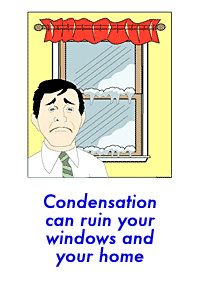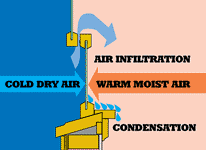|

|

Condensation
When it comes to Vinyl Replacement Windows or Installing Windows, there are many reasons why the old windows failed.
Perhaps the most annoying problem that can occur in windows, especially in colder climates, is condensation. Each time the temperature drops outside, water vapor condenses on the inside surface of glass and drips over the sash and onto the sill. Over time, especially on wood windows, this moisture can destroy the inside finish of the window, eventually discoloring it beyond repair.
In extreme cases over longer periods of time, this moisture can rot the wood and even cause de-glazing of the sash.
In addition to defacing the finish, Condensation can warp the wood, and cause ice buildup, freezing the windows shut making their operation all but impossible.
Condensation can only be controlled if the conditions that support it are controlled: moisture content in the air; and temperature of the window's interior surface. If the moisture content is high, the temperature of the window surface doesn't have to get too low for Condensation to occur. If the moisture content of the air is low, then the window surface can have a lower temperature before Condensation occurs.
Even though we may keep cold air out of a room (air infiltration), cold that is conducted in on window glass or frame material can cause condensation to begin if the temperature of the inside surface is below the dew point of the room's air. If the temperature is below freezing, then the condensation will appear as frost.
Can Condensation be prevented?
Condensation can't be prevented in principle, but it can be controlled two ways:
1. Reduce moisture at its source. There are many sources in the house. Mopping the kitchen floor can release 4-1/2 pints of water vapor; a shower or bath about 1/2 pint; washing the dinner dishes about 1/2 pint; and a family of 4 can give off about 1/2 pint per hour by just breathing. It takes only about 5 pints of water to raise the relative humidity of 1000 square feet from 15% to 60%! Though the relative humidity will be concentrated in the rooms where it was created, eventually it will disperse throughout the house. When the weather gets colder, put off some of these activities until the warmer parts of the day and condensation will be a lesser problem.
2. Raising window surface temperatures. If the temperature of the interior surfaces of window frames and glass, is kept warmer it will raise the dew point and less condensation will result. Frame material of vinyl, with multi-cavity design can keep the interior surface of the frame material a lot warmer due to the non-conductivity of vinyl, and the insulating ability of the air in the cavities. Insulated glass, Low"E" glass, and gas-filled insulating glass can raise interior glass surface temperatures 42 degrees over single pane glass.
Vinyl Replacement Windows will allow you to best resist condensation conditions. Then by keeping the moisture levels as low as possible, you will be able to control condensation so it is no longer a problem.
|